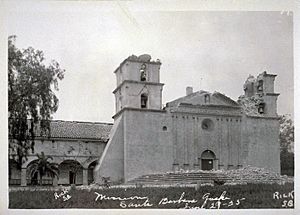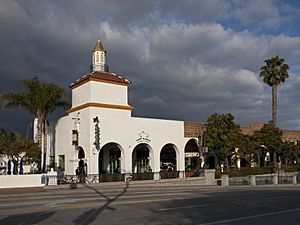1925 Santa Barbara earthquake facts for kids
| UTC time | 1925-06-29 14:42:16 |
|---|---|
| ISC event | 910569 |
| USGS-ANSS | ComCat |
| Local date | June 29, 1925 |
| Local time | 06:44 |
| Magnitude | 6.5 Mw; 6.8 Mw |
| Depth | Unknown |
| Epicenter | 34°18′N 119°48′W / 34.3°N 119.8°W |
| Type | probably left-lateral reverse |
| Areas affected | Central Coast (California) United States |
| Total damage | $8 million |
| Max. intensity | IX (Violent) |
| Casualties | 13 |
The 1925 Santa Barbara earthquake was a powerful earthquake that shook Santa Barbara, California, on June 29, 1925. It had a strength, or magnitude, between 6.5 and 6.8. The shaking was very strong, reaching a Mercalli Intensity of IX, which means Violent.
This earthquake caused 13 deaths and destroyed the old part of the city. The damage cost about $8 million at the time. That would be around $111 million today!
Contents
The Big Shake
Before the main earthquake, there were no small shakes, called foreshocks, that people felt. However, a special machine at the waterworks recorded some movement starting at 3:27 a.m. These were likely tiny foreshocks.
What Happened During the Quake?
The main earthquake hit at 6:44 a.m. and lasted for 19 seconds. Its center, called the epicenter, was in the ocean near Santa Barbara. This was in the Santa Barbara Channel. Scientists think the earthquake happened on a fault line that was part of the Mesa fault or the Santa Ynez system.
People felt the earthquake far and wide. It was felt from Paso Robles in the north to Santa Ana in the south. It was also felt as far east as Mojave.
How Much Damage Did It Cause?
Santa Barbara suffered a lot of damage, especially in its downtown area. Areas along the coast and north of the Santa Ynez Mountains were also hit hard. This included the Santa Ynez and Santa Maria valleys.
Even though 13 people died, the situation could have been much worse. Three brave people quickly turned off the town's gas and electricity. This stopped huge fires from starting, which often happen after earthquakes.
Most homes in Santa Barbara survived fairly well. However, almost every chimney in the city fell down. The main downtown area was ruined. Only a few buildings on State Street, the main shopping street, were left standing.
Large parking garages, like the City Cab building and the Californian and Arlington garages, collapsed. They were full of cars at the time. Many other cars were crushed in the downtown area. One person died when building walls fell onto cars near the San Marcos building.
In the business district, an area of about 36 blocks, most buildings were badly damaged. Many had to be completely torn down and rebuilt. The front of the Mission Santa Barbara church was severely damaged, and its statues fell off. Many important buildings, like hotels, offices, and the Potter Theater, were lost. The courthouse, jail, library, schools, and churches also had serious damage.
Concrete curbs in Santa Barbara buckled on almost every block. The road along the beach moved by about 8 to 14 inches (20-36 cm). But the roads downtown mostly stayed in place.
The Sheffield Dam, built in 1917, was near the city. It was 720 feet (220 m) long and 25 feet (7.6 m) high. It held 30 million US gallons (114 million liters) of water. The soil under the dam turned into liquid during the earthquake, and the dam broke apart. This was the only dam in the U.S. to fail during an earthquake until 1971. When it burst, a wall of water rushed through the lower part of town. It destroyed trees, cars, and three houses, flooding the area up to 2 feet (0.61 m deep).
The Southern Pacific Railroad tracks were damaged in several spots. This happened between Ventura and Gaviota. A section between Naples and Santa Barbara was especially damaged and moved out of place. Cliffs along the ocean fell into the sea. A small tsunami (a large ocean wave) was noticed by ships offshore.
The town lost all telephone and telegraph service. News from outside the city arrived only by shortwave radio. Because there were no big fires after the earthquake, scientists could study how different types of buildings were damaged.
The American Legion and the Naval Reserves helped keep order. They set up patrols to stop people from stealing from damaged businesses and homes. More police and firefighters came from places like Los Angeles to help.
Aftershocks
Three strong aftershocks happened in the next few hours. These are smaller earthquakes that follow the main one. They occurred at 8:08 a.m., 10:45 a.m., and 10:57 a.m. These aftershocks did not cause more damage. Many smaller shakes continued throughout the day. An aftershock on July 3 caused more cracks in walls and damaged chimneys.
Rebuilding Santa Barbara
Since downtown Santa Barbara was so badly damaged, a huge rebuilding effort began in 1925 and 1926. Workers removed or fixed damaged buildings and built new ones. This changed the look of the city center completely.
Before the earthquake, much of the city center was built in the Moorish Revival style. After the earthquake, leaders decided to rebuild it in the Spanish Colonial Revival style. The Santa Barbara Community Arts Association led this effort. They saw the earthquake as a chance to rebuild the city with a single, beautiful architectural style.
Many architects were asked to design the new buildings. These included James Osborne Craig, George Washington Smith, Carleton Winslow, Bertram Goodhue, and Winsor Soule. As a result, many buildings built in the late 1920s are now listed on the National Register of Historic Places. Examples include the Santa Barbara County Courthouse and the front of the Andalucia Building.
New Building Rules
The earthquake showed that old building methods, like using concrete, brick, and stone without strong support, were not safe. These buildings could not survive strong earthquakes. Because of this, Santa Barbara made its building codes much stricter. New rules made sure buildings were safer and stronger.



